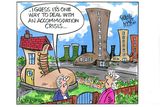It might be a bumpy ride but we are heading the right way to recovery
The HSE’s demands for a €2bn rise in funding next year have been dismissed as 'unrealistic' by Public Expenditure Minister Brendan Howlin
The numbers at work are rising at their fastest rate since the crash. All eight regions of the country are enjoying a recovery in employment. Most sectors of the economy are adding people to payrolls.
This excellent news about the labour market in the April-June months of this year came yesterday from the State's number crunchers.
Along with sheaves of data on the latest happenings on the jobs front, they also revealed their latest numbers on emigration and immigration, both of which are perennially hot topics.
In the 12 months to April 2015, fewer people left compared to the previous 12-month period and the numbers arriving grew.
Both developments (broadly) corroborate the evidence from the jobs market data, which show that employment opportunities are becoming more plentiful.
If you want to know what's going on in the economy, yesterday's numbers on jobs and migration tell a lot more, and tell it a lot more accurately, than the oft-cited GDP and GNP figures.
Those latter numbers are increasingly unreliable as indicators of what is happening on the ground across the economy. They show, for instance, that the economy is booming like it was 1999. Alas, it is not. But it is growing very strongly.
Let's start with a more detailed look at jobs numbers, as they are the most important and reliable indicator of what is happening in the economy.
In the three months to June, there were almost 20,000 more people at work than in the first three months of the year. This continues a trend in evidence for the past three years.
That positive trend goes some way (or almost 40pc of the way, to be precise) to reversing the decline in employment - of one third of a million - from the peak of the boom to the trough of the recession.
Another trend that has continued is the geographically widespread nature of the jobs recovery. Contrary to frequent claims, mostly from outside the Pale, the recovery is not only a Dublin-centred phenomenon.
Indeed, three of the State's eight regions - the border counties, the midlands and the south-east - have all enjoyed more rapid growth in employment than the capital over the past three years.
And even in the regions that were the slowest to recover - the west and the mid-west - there are signs of a turnaround, if not quite yet of a take-off. Over the past year, the growth rate in employment in those two regions has perked up to meet the average across the entire country.
None of this is to say that the more peripheral parts of the country don't face serious problems and that there are not regional disparities, but these shouldn't be exaggerated, as the joblessness figures attest.
The range of regional unemployment rates - the lowest in Dublin, at 8.1pc; highest in the south-east, at 12.6pc - is narrower than most other countries, according to pan-European data.
One reason for the geographically broad recovery in employment is the breadth of the recovery across different industries.
The statisticians break the jobs market into 14 different sectors, from agriculture to public administration. In the year to the second quarter of 2015, 11 sectors recorded growth in the numbers at work, with the previously decimated construction sector leading the way by a distance. Other high-growth sectors include finance and real estate, manufacturing and information technology.
Along with the education and administration groupings, the hospitality sector was the only one to record a decline in employment on a year earlier. This is one of the few negatives to be found in the vast quantity of data published yesterday - and somewhat curious, given the good year that 2015 seems to have been for tourism.
If lots of people have been coming to Ireland to visit, there has also been an increase in the numbers coming here to settle. Yesterday's publication of migration figures for the year to April shows that almost 70,000 people moved to the Republic, an increase of almost 10,000 on the previous 12-month period.
Only a fraction - 12,000 - of these were Irish people returning home. This is somewhat surprising, given that natives usually have better networks, which enable them to better take advantage of any upswing in the labour market.
It is even more surprising - given the difficulties getting work permits - that more than half of the foreigners who moved here were from outside the EU.
Further reflecting the improving economy is the (admittedly) small decline in emigration, down by 1,000 people to 81,000. But here, developments are more as one might expect, with the number of Irish people emigrating falling by 5,000 to 35,000.
With plenty of good news on the home front, what about the dark clouds on the international horizon?
The outbreak of panic on financial markets from Shanghai to New York in recent weeks, and its intensification over the past few days, has led to fears that the world could be in for another bout of slower growth or even outright recession. The greatest concerns have been focused on the world's second-biggest economy - China.
That country's stock markets have suffered the sort of decline not experienced since the country abandoned murderous Maoism in the 1970s. Although one can never say for certain, there is a lot of evidence pointing to a big credit bubble in China. If it turns out to be as big as it seems, its bursting would hurl China's long-booming economy into recession.
That would have some negative impact on us in Europe, although because that country only accounts for a fraction of our exports (2pc in Ireland's case) it should not spell disaster.
More worrying than the trade channel between China and Europe is the financial channel. If a widening of the stock market panic were to spill over into the eurozone's government bond market, the weak recovery across the continent could be derailed.
All that said, and despite the heightened risk, the chances are that Europe and Ireland will continue to recover over the next few months, in part because the European Central Bank is busily buying up government bonds via its 'quantitative easing' programme.
If there is no external shock and if the jobs growth recorded in the spring is maintained, then something akin to a full recovery from the property crash could be arrived at on its tenth anniversary.
An additional 20,000 jobs each quarter would mean that by Christmas 2017 the pre-crisis level of employment would be reached.
That would be quite a Christmas present.
Join the Irish Independent WhatsApp channel
Stay up to date with all the latest news















